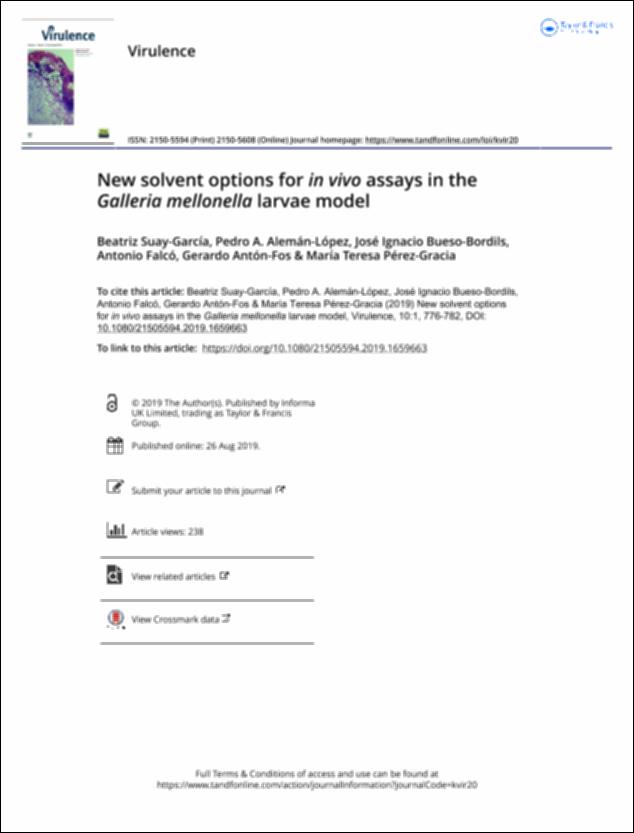Por favor, use este identificador para citar o enlazar este ítem:
http://hdl.handle.net/10637/10964New solvent options for in vivo assays in the "Galleria mellonella" larvae model
| Título : | New solvent options for in vivo assays in the "Galleria mellonella" larvae model |
| Autor : | Suay García, Beatriz Alemán López, Pedro Bueso Bordils, José Ignacio Falcó Montesinos, Antonio Antón Fos, Gerardo Manuel Pérez Gracia, María Teresa. |
| Materias: | Insectos - Larvas - Experimentación biológica y médica.; Biological assay.; Solvents - Animal models.; Insects - Larvae - Experiments.; Disolventes - Modelos animales.; Ensayos biológicos.; Pruebas de toxicidad.; Toxicity testing.; Gusano de la cera - Experimentación biológica y médica.; Galleria mellonella - Experiments. |
| Editorial : | Informa UK. |
| Citación : | Suay-García, B., Alemán-López, PA., Bueso-Bordils, JI., Falcó, A., Antón-Fos, G. & Pérez-Gracia, MT. (2019) New solvent options for "in vivo" assays in the "Galleria mellonella" larvae model. Virulence, vol. 10, n. 1 (26 aug.), pp. 776-782. DOI: https://doi.org/10.1080/21505594.2019.1659663 |
| Resumen : | Experimentation in mammals is a long and expensive process in which ethical aspects must beconsidered, which has led the scientific community to develop alternative models such as that ofGalleria mellonella. This model is a cost and time effective option to act as a filter in the drugdiscovery process. The main limitation of this model is the lack of variety in the solvents used toadminister compounds, which limits the compounds that can be studied using this model. Fiveaqueous (DMSO, MeOH, acetic acid, HCl and NaOH) and four non-aqueous (olive oil, isopropylmyristate, benzyl benzoate and ethyl oleate) solvents was assessed to be used as vehicles fortoxicity and antimicrobial activityin vivoassays. All the tested solvents were innocuous at thetested concentrations except for NaOH, which can be used at a maximum concentration of 0.5 M.The toxicity of two additional compounds, 5-aminosalicylic acid and DDT, was also assessed. Theresults obtained allow for the testing of a broader range of compounds using wax moth larvae.This model appears as an alternative to mammal models, by acting as a filter in the drugdevelopment process and reducing costs and time invested in new drugs. |
| Descripción : | Este artículo se encuentra disponible en la siguiente URL: https://www.tandfonline.com/doi/full/10.1080/21505594.2019.1659663 |
| URI : | http://hdl.handle.net/10637/10964 |
| Derechos: | http://creativecommons.org/licenses/by/4.0/deed.es |
| ISSN : | 2150-5594. 2150-5608 (Electrónico). |
| Fecha de publicación : | 26-ago-2019 |
| Centro : | Universidad Cardenal Herrera-CEU |
| Aparece en las colecciones: | Dpto. Farmacia |
Los ítems de DSpace están protegidos por copyright, con todos los derechos reservados, a menos que se indique lo contrario.


